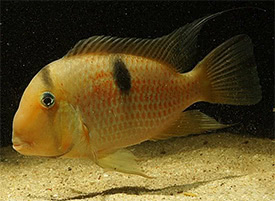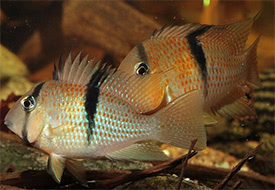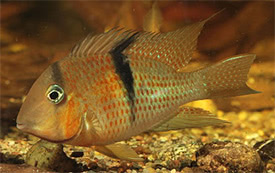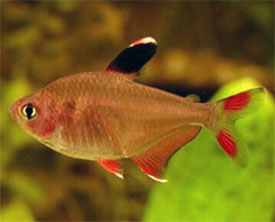Guianacara sphenozona - -
 Magyarul / Hungarian
Magyarul / Hungarian

 Magyarul / Hungarian
Magyarul / Hungarian





- Scientific name: Guianacara sphenozona
- Synonyms: -
- Common name: -
- Group: Cichlids
- Distribution: South America; Sipaliwini and middle Corantijn River drainages in Suriname, and the Essequibo River basin in Guyana.
- Size: 9-11 cm
- Biotope: Mostly found in clear waters with a substrate of large rocks intermixed with sandy patches in fast-flowing smaller rivers and streams.
- Social behavior: Intraspecific aggression and territorial behaviour in generally quite high, although battles do not lead to injury, but basically a quite peaceful fish, They can be kept in a community aquarium with other peaceful fish that inhabit the upper levels of the tank. They do not harm plants.
- Diet: Omnivorous; They will eat live, frozen and quality dried foods too. Occasionally give them some vegetable matter, such as spirulina algae tablets or spinach.
- Breeding: Quite easy
- Tank: Minimum 150 litres
- Population: 1 pair for 150 litres
- Decoration: Use a sand or fine gravel substrate, because they like to dig. Therefore only robust, potted plants should be used as they may uproot them. Use larger rocks, roots and driftwoods to create many hiding places.
- Temperature: 25-30 °C
- pH: 6.0-7.0
- Hardness: 1.0-10.0 dGH
- Lifespan: 5-8 years
Description: All the Guianacara species are very much alike in appearance and are discriminated chiefly by the extent and size of the midlateral bar or spot and the head stipe in the different species. It is often hard to identify a species, because their coloration is mood-related. The base coloration is yellowish-green or beige with bluish flanks. Guianacara sphenozona exhibits a flank stripe which is most strongly marked on and above the upper lateral line and may extend some distance into the dorsal. The flank stripe may take the form of the tapering black wedge that gives the species its name or be reduced to a spot on the lateral line. The fish exhibits smaller spots on the dorsal fin, and these spots are restricted to the soft part of the fin. In Guianacara sphenozona the suborbital stripe which runs across the cheek to the preoperculum, is slightly curved and indistinct at the edges. Guianacara sphenozona is very easy to keep in the aquarium, several pairs can be kept together in aquaria with a capacity of at least 300 litres and a length of no less than 120 cm. The temperature should relate to the natural habitat and not drop below 25 °C.
Adult males grow larger and appear significantly beefier than females.
Guianacara sphenozona is cave-spawner fish, after a short courtship and intensive cleaning of the substrate the eggs are attached to a vertical surface. While the female tends the eggs the male guards the territory. The larvae hatch after about 6 days and are moved around from pit to pit by the female for a further 5 days. The fry then become free-swimming and should now be fed with newly-hatched Artemia.
Sources:
https://www.fishbase.se/summary/Guianacara-sphenozona.html
South American Eartheaters
http://www.tfhmagazine.com/details/articles/two-new-bandit-acaras-from-venezuela.htm
https://www.fishbase.se/summary/Guianacara-sphenozona.html
South American Eartheaters
http://www.tfhmagazine.com/details/articles/two-new-bandit-acaras-from-venezuela.htm
Hasonló vízparamétereket igénylő fajok


























































